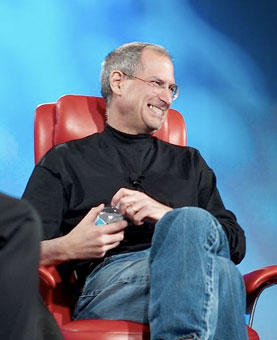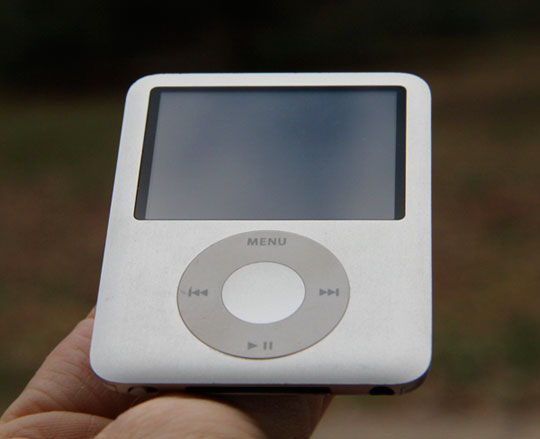Steve Jobs, Simplifier
by Roger Kaza
Today, the man who made it simple. The University of Houston presents this program about the machines that make our civilization run, and the people whose ingenuity created them.

Steve Jobs in 2007
A poignant technological footnote from 2011: when Steve Jobs died, many of us heard the news via our iPhones, iPads, or personal computers. I've just finished Walter Isaacson's mammoth biography of Jobs, and by the end found myself grasping and groping for some label to pin on the man. In the obituaries and tributes he was often compared to Thomas Edison. That's flattering, but doesn't ring quite true. Though Jobs name appears on dozens of patents, he really didn't invent anything new. There were MP3 players before the iPod, there were smartphones before the iPhone, and there were even personal computers before Apple started making them in 1977, though just barely. What Jobs did was take clunky things and turn them into beautiful, elegant things.
More importantly, he took complicated things and made them simple, well, as simple as they could possibly be. Jobs embodied the motto of the Swiss poet Henry Amiel: the great artist is the simplifier. So when all the other accolades are exhausted: genius, entrepreneur, visionary, etc, etc. — simplifier is what I will call Steve Jobs.
There's dozens of examples. The most famous is the so-called GUI, short for graphical user interface, how we interact with our computer screens with a mouse or trackpad. Before GUI, you talked to the computer by tediously typing code. Apple didn't of course invent GUI, Xerox did. Xerox granted Apple access to their top-secret research lab, and in return they got to invest in Apple stock. When Jobs saw GUI for the first time, he went ballistic. He knew in an instant it was the future of computers.
Plus Apple's version was even better — and simpler — than Xerox's. That feature on our computers we take for granted, where the window we're working on always seems to be magically 'in front' of the other windows? Obviously there's no 'front' and 'back' on a two-dimensional computer screen, but it's an illusion as convincing as the sun rising and setting. One of Jobs' engineers created stacked windows, because he thought he'd seen it at the Xerox lab. He hadn't. Xerox was amazed when they saw Apple's innovation.
Achieving simple, however, is often anything but. As Isaacson points out, Jobs had several opposing traits that were the yin and yang of his success. One was a fondness for the aesthetics and philosophy of Zen Buddhism. Go to a temple in Kyoto, Japan to see simplicity and purpose in every wooden beam. The flip side of this Zen repose was a ruthless demon of perfectionism, which he unleashed upon his troops on a daily basis. That part of Jobs' story calls to my mind the stereotypical symphony conductor of the last century. Instead of brainy Thomas Edison, maybe we should think, temperamental Arturo Toscanini. Steve Jobs set the same kind of rarified standards for what he dubbed his 'insanely great' products. And any dissonant human notes along the way were but a small price to pay for the ultimate goal of simple harmony with our machines.

Four button simplicity. iPod nano, 3rd generation
I'm Roger Kaza, from the University of Houston, where we're interested in the way inventive minds work.
Isaacson, Walter: Steve Jobs. Simon & Schuster, October, 2011. Chapter 12 (p. 125) deals extensively with Jobs' design aesthetic and its philosophic and artistic roots.
Timeline of the earliest personal computers. Fascinating additional links regarding each computer.
An early PC pioneer recalls Steve Jobs at the beginning of his career.
An often-asked question regarding the history of the PC is why Xerox didn't market the first GUI computer, since they invented the concept. Actually, they did build a PC, marketed mainly to corporations. But Xerox's GUI computer, called Star, cost approx. $17,000. The Macintosh sold for $2,500. Market share beats innovation every time!
The Apple software engineer mentioned above who invented stacked windows was Bill Atkinson.
'Simple can be harder than complex: You have to work hard to get your thinking clean to make it simple. But it's worth it in the end because once you get there, you can move mountains.'
— Steve Jobs
Photo of Steve Jobs: Joi Ito, Wikimedia Commons
Photo of iPod: Roger Kaza
This episode was first aired on December 28, 2011